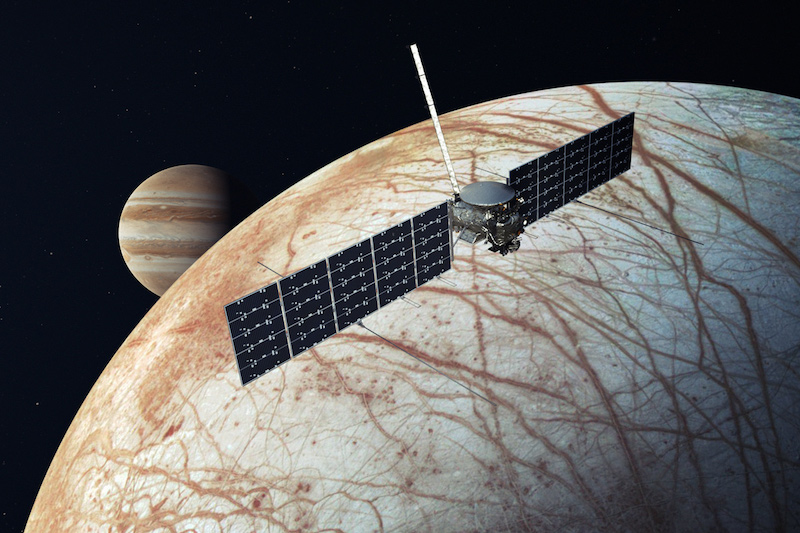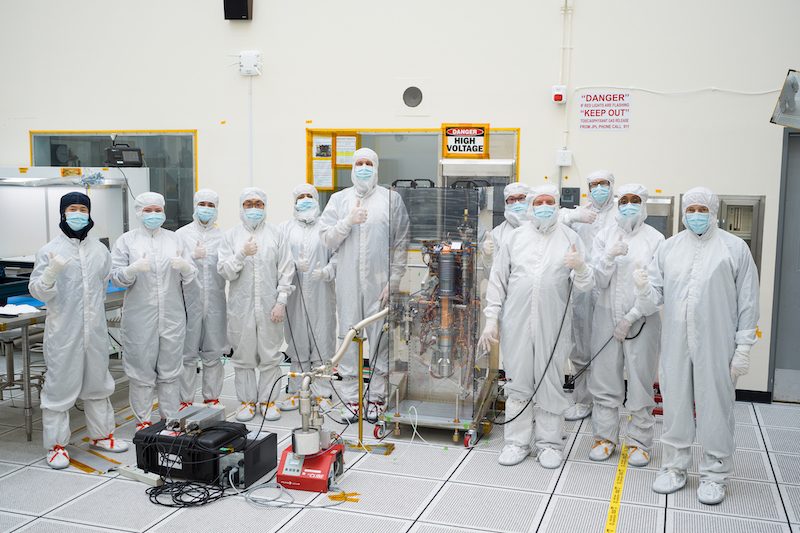
Last month (December 2022), engineers and technicians at NASA’s Jet Propulsion Laboratory in Pasadena, California received a new instrument for the Europa Clipper mission to Jupiter’s moon Europa. It’s now ready to be integrated into the spacecraft, which is due to launch to Jupiter’s ocean moon in late 2024.
The instrument – called a MAss Spectrometer for Planetary EXploration (MASPEX) – will basically act as Europa Clipper’s “nose.” It’s designed to sniff out gases on and around Europa, to help assess the habitability of this ocean moon of Jupiter. The Southwest Research Institute (SwRI) designed and built MASPEX.
Advanced new mass spectrometer for Europa Clipper
One of nine instruments on Europa Clipper, MASPEX is the most sophisticated mass spectrometer yet designed to fly in space. MASPEX will study the chemistry of Europa, including its surface, atmosphere and subsurface ocean. It does so by analyzing gases at Europa to determine their composition. This provides valuable clues as to conditions not only on the frozen surface, but deeper down in the salty ocean itself. Also, MASPEX will look at how the surface and ocean exchange material. In addition, it will examine how Jupiter’s strong radiation affects materials on Europa’s surface.
SwRI Senior Vice President and MASPEX principal investigator Jim Burch explained, saying:
MASPEX has a mass resolution hundreds of times finer than anything that has flown to space before. SwRI has used internal funding and NASA resources to develop an instrument able to differentiate between molecules with almost identical masses based on the energy binding the atoms. It also differentiates isotopes, atoms with equal numbers of protons but a different number of neutrons. These capabilities are critical to revealing the secrets of Europa.
SwRI’s Steve Persyn, project manager for MASPEX, said:
It has been a huge team effort to get this next-generation space mass spectrometer built, tested and delivered. SwRI has decades of experience designing and building instruments for space missions.

How MASPEX works
So, how does MASPEX work? Generally speaking, the premise is fairly simple. The instrument sucks in gas molecules from Europa and then converts them into ions. Ions are any atom or group of atoms that have one or more positive or negative electrical charges. Then, the ions bounce back and forth inside the instrument about 400 times. While the ions are moving, MASPEX measures their mass. Knowing the exact mass helps scientists determine the composition of the atoms and molecules.
MASPEX also differentiates between isotopes, which are atoms with equal numbers of protons but a different number of neutrons.
Europa Clipper won’t land on Europa itself, but it will conduct numerous close flybys of the moon. It’s also possible for Europa Clipper to fly through some of Europa’s water vapor plumes – if they do exist – and sample them directly. Imagery and other data from telescopes such as Hubble have provided tentative but good evidence for their existence. However, some scientists still debate if these actually are plumes. If so, they seem to be similar to the plumes on Saturn’s moon Enceladus, but more intermittent and smaller-scale.
Christopher Glein, MASPEX co-investigator and planetary geochemist, said:
We hope to identify and fly through plumes and other sources of gas venting from cracks in Europa’s icy surface. We know microbes on Earth exploit any molecule that can serve as a food source. MASPEX is going to help Europa Clipper determine whether there is anything for microbes to eat, such as organic molecules that might be sourced from hydrothermal vents at the bottom of a deep ocean. The data from this exciting mission will give us a much richer perspective on the habitability of Europa.
Europa in unprecedented detail
Europa Clipper is scheduled to launch in 2024 and arrive at Jupiter and Europa in 2030. It is the first mission dedicated to studying Europa and its subsurface ocean in unprecedented detail. It will provide scientists with a much better understanding of Europa’s ocean and its potential habitability. And, perhaps, even more clues as to the presence of life itself.
Last November, engineers also installed Europa Clipper’s four large reaction wheels. They will help keep the spacecraft oriented in the right direction to conduct its science investigations and send the data back to Earth.
Bottom line: NASA has received an advanced mass spectrometer for the Europa Clipper mission. It will analyze gases for clues about the ocean moon’s habitability.











